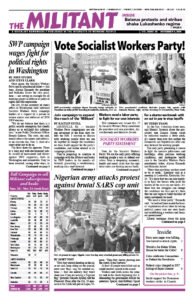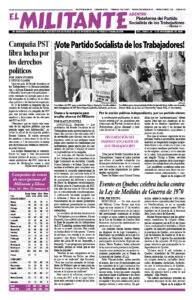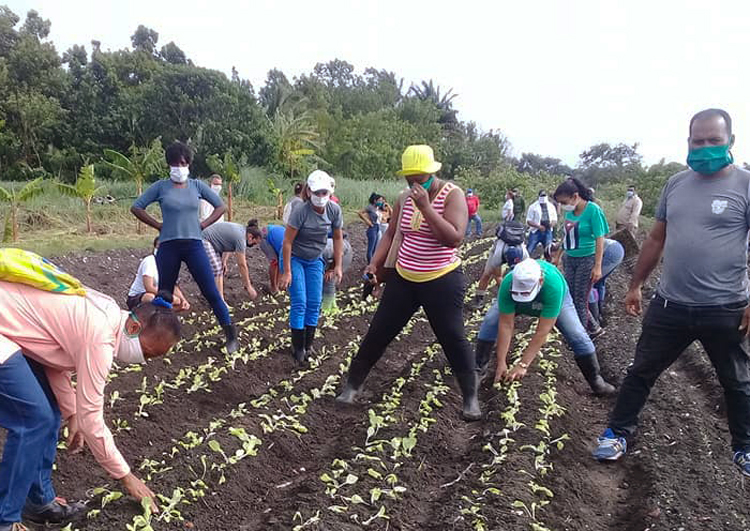Working people in Cuba in September celebrated the 60th anniversary of the founding of the Committees for the Defense of the Revolution (CDRs), the country’s largest mass organization with more than 8 million members in neighborhoods in cities and countryside.
Even with special measures in place to protect people during the coronavirus pandemic limiting some activities, it was a day of rejoicing with workers decorating their houses, apartment buildings and streets with flags and banners, and some public events to mark the anniversary.
The CDRs have been at the forefront of supporting the Cuban public health system in halting the spread of COVID-19. In addition to the 28,000 medical students who have been making daily house visits to check on everyone’s health, brigades of volunteers organized by the CDRs, the Federation of Cuban Women, the Union of Young Communists and other mass organizations are ensuring that children with disabilities, the elderly living alone, and others in need of assistance receive their meals and medications, and to run errands for them.
Others volunteer for brigades to clean quarantine centers and to provide company to patients staying there. These mobilizations reflect the fact that Cuban workers and farmers see the government as their own, and use their organizations to help it meet every challenge.
When nearly 1 million people gathered in Havana Sept. 28, 1960, to hear Cuban leader Fidel Castro speak after returning from a U.N. General Assembly session, U.S.-backed counterrevolutionary terrorists set off several bombs nearby.
CDRs born out of revolution
“If they think they can stand against the people, they are going to be hugely disappointed! We’ll put in place a committee of revolutionary vigilance in every block,” Castro responded to an ovation. “When the masses are organized there isn’t a single imperialist, or a lackey of the imperialists who can make a move.” And the CDRs were born.
They grew to become a vibrant national organization capable of mobilizing millions in defense of the revolution.
The formation of neighborhood committees to guard against counterrevolutionary activity came at a turning point of the revolution, then less than 2 years old. Workers and peasants were mobilizing to take control of the fields and factories, and the revolutionary government was nationalizing the formerly imperialist-owned banks and industries.
As it became clearer and clearer to Cuban capitalists and the U.S. rulers that they would no longer be able to exploit the people and resources of Cuba, Washington accelerated its political, economic and military efforts to overturn the revolution.
This is the course Washington has pursued for over 60 years, under every administration, Democratic or Republican: a brutal economic war aimed at the Cuban people. And the response by working people and their CDRs has earned a special hatred from enemies of the revolution.
The CDRs came into being as revolutionary forces were taking leadership in the unions, and women, farmers, and students were forming their own organizations. These organizations — along with the workers and peasants militias and the revolutionary armed forces — formed the foundation for the new popular government, as it began transforming society for the benefit of the toilers, not the capitalists.
Toilers’ capacities unleashed
A quick look at the history of the CDRs gives a flavor of how the revolution unleashed the creativity, resourcefulness and capacities of working people to use their organized power to confront all challenges to the revolution.
They were decisive in neutralizing counterrevolutionary activities leading up to and after the April 1961 U.S.-organized invasion at the Bay of Pigs, and in fighting petty capitalists who sought to profit from hoarding and speculating with food and other necessities.
In 1962, when the Kennedy administration was tightening its economic embargo and preparing a U.S.-organized military invasion, the CDRs guaranteed the distribution of food and other supplies to the population, and organized 12,000 medical brigades of 300,000 members. They attended first aid courses, made stretchers, and constructed bomb shelters. They organized retired workers, housewives, and students who volunteered to take the place of workers who left to staff the front lines.
They were centrally involved in the national campaigns to eliminate illiteracy in 1961; and a year later to administer the polio vaccine to over 2 million children under the age of 15.
Albert Sabin, developer of the oral polio vaccine, visited Cuba in 1963, astonished by the eradication of polio in a single campaign. It took six more decades for polio to be eliminated in the rest of the world.
A description of these giant transformations can be found in the book Women in Cuba: The Making of a Revolution Within the Revolution, published by Pathfinder.
‘No one left to fend for themselves’
Also in 1963, the CDRs collected clothing and toys for the hundreds of thousands of victims of Hurricane Flora. The CDRs have been the heart of Cuba’s emergency response system that saves lives every year, preventing natural disasters from becoming social catastrophes. “No one is left to fend for themselves!” is the principle that guides them.
And they’ve stepped forward to aid toilers in other countries facing similar conditions. On repeated occasions they’ve organized special drives to donate blood, for example, to people in Peru in 1970 and Armenia in 1988 in response to earthquakes there.
Over decades the CDRs have helped extend access to culture to working people by creating libraries, organizing music and other festivals, and providing ongoing support for the schools in their neighborhoods. In June 1962, the CDRs sponsored a performance by the Cuban National Ballet that was attended by 50,000 people at the Latin American Stadium. They saw internationally acclaimed Cuban dancer Alicia Alonso, members of the national ballet she directed and 140 dance students perform Giselle.
Fighting food scarcity today
Over the years, the CDRs have mobilized hundreds of thousands of volunteers to help bring in the sugar cane harvest and in other agricultural production.
Today, Cuba faces growing scarcity of some foodstuffs, as a result of the drastic drop in production, trade, and tourism due to the coronavirus pandemic — exacerbated by Washington’s stepped-up sanctions. The CDRs and other mass organizations have responded by organizing to increase food production.
The tasks of the CDR “continue to be the same: to defend the revolution in each neighborhood and each block,” Gerardo Hernández, recently elected CDR national coordinator, said at the main anniversary celebration held in Havana. Hernández was one of the “Cuban Five” revolutionaries who spent up to 16 years in U.S. prisons for gathering information for the Cuban government on the actions and plans of counterrevolutionary groups in the U.S. with a long history of murderous attacks in Cuba.
“If someone asked, what’s the mystery behind this revolution?” Hernández said, quoting from a speech given by Fidel Castro at the fourth congress of the CDRs in 2003, “there could not be any other answer than the fact that it rests on the organized masses.”


